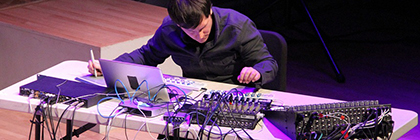The School of the Arts, Media, Performance & Design (AMPD) at York University has launched two important ventures in the span of four short years ̶ Sensorium and the AMPD Motion Media Studio @ Cinespace – both of which embody the leading edge of creative practice at the intersection of the arts and technology. This remarkable and comprehensive Faculty envelops and embraces technology. It is unique in that it both creates devices and the content for new and existing devices, incorporating partnerships that are facilitated by a genuine and highly imaginative kind of engagement.
It’s not just the arts talking to the arts, it’s an interdisciplinary endeavour where projects are immersed in legal, medical, urban planning, business and many other realms.

“We stand on the threshold of a dramatically new, radically different kind of arts future – a world in which the communication of our ideas and their physical and virtual expression have extraordinary value and are becoming the new currency of the creative economy,” explains Professor Shawn Brixey, AMPD dean.
Sensorium fosters collaborative research and encourages partnerships
Sensorium, an ambitious research centre that opened in 2013, is based around one central and compelling idea: the impact of digital technologies on the creative knowledge industries. As a result, one would be hard-pressed to find a more all-encompassing idea of art. This new environment supports cross-disciplinary work in application and content creation, artistic and scientific inquiry, policy development and critical discourse in digital media arts.

“Sensorium serves as a catalyst for new ideas and experimentation, linking creative expertise and labs in AMPD, fostering collaborative research, and encouraging community and industry partnerships,” says Professor Doug Van Nort, interim director of Sensorium, Canada Research Chair in Digital Performance and the founding director of the DisPerSion (DIStributed PERformance and Sensorial ImmersION) Lab.
The eight key research areas in Sensorium, which effectively marry digital technologies with human factors, are as follows:
- Future Cinema: 3D and interactive cinema, ubiquitous screens and architectural projections;
- Advanced Digital Imaging and Form Finding: animation, motion graphics, and 3D modelling;
- Sustainability for Theatre and the Expanded Stage: lighting and sustainable technologies and motion tracking;
- Art/Science: bio art, collaborative methodologies between artists and scientists, and new scientific innovation and understanding;
- Mobile and Augmented Media: digital storytelling and virtual environments;
- Interactive Environments and Games: human-computer interface, computer graphics, avatars and game engines, and data visualization;
- The Digital Commons and Social Media: digital archives, e-citizenship and activist media; and
- Informatics and Data Visualization: data mining, signal processing and information aesthetics.
Lab bridges technology and art to tell enriched stories
AMPD Professor Caitlin Fisher’s Augmented Reality (AR) Lab is a perfect example of the groundbreaking work undertaken at Sensorium, and the interface between technology and art.

AR refers to adding a digital layer to what we see and experience. Fisher’s state-of-the-art lab offers some of the most advanced technology available anywhere in the world. Here, she investigates the idea of storytelling through AR hardware development, software creation and content development. She invents, designs, builds and deploys sophisticated AR technology that, when worn by the viewer as headgear, effectively creates the illusion of having something else in the visual space. AR Glass, for example, is a pair of glasses that provides digital information about what the viewer is seeing.
“This is an important point in time for Canadian innovation in AR research, with practical application,” emphasizes Fisher, a former Fulbright Research Chair and Canada Research Chair in Digital Culture. “We are on the cusp of what is predicted to become a $200 billion industry.”
This lab, facilitated through an Insight Grant from the Social Sciences & Humanities Research Council, is also a prime example of partnerships, as students here are often involved in international partnerships. The AR Lab itself is part of the Ontario Augmented Reality Network and has collaborated with Georgia Tech, the Ontario Science Centre, TIFF/Nexus and Millenium3 Engineering among others.
AMPD Motion Media Studio builds strong connections between industry and education
In May 2016, AMPD got another huge boost: a $2.5 million gift from Cinespace Film Studios and the Mirkopoulos family to create a new York University AMPD Motion Media Studio @ Cinespace. The new facility opened to students in fall 2016.
Located next to professional sound stages being used for major television and film productions, the Motion Media Studio offers students unique experiential learning opportunities, hands-on training in new media technologies and direct exposure to industry.
More specifically, it enables AMPD students to explore the creation, convergence and application of next-generation arts and entertainment media technologies, with a focus on moving image production, including 3D stereoscopic cinema; virtual, augmented and mixed reality; interactive performance; gaming; interactive data visualization; and more.

“These state-of-the-art facilities support the creation of powerful and innovative technologies, and build strong connections between industry and education that are key to supporting our emerging cultural leaders,” says Michael Longford, associate professor in computational arts, who played a key role in getting the AMPD Motion Media Studio @ Cinespace up and running.
One example is particularly captivating: This new facility comes equipped with Organic Motion’s markerless motion capture technology OpenStage2, eliminating the need for the bodysuits and markers currently used in film animation. With this technology, York students will be able to create 3D animations, design interactive games and simulations, and integrate virtual performers for dance and theatre productions, without complicated setups.
“The Motion Media Studio @ Cinespace will electrify the imagination of a new generation of artists and prepare our students to be front runners in tomorrow’s creative digital sphere,” adds Brixey.
For more information, visit the Sensorium website or read past YFile articles about Sensorium and the AMPD Motion Media Studio @ Cinespace.
By Megan Mueller, manager, research communications, Office of the Vice-President Research & Innovation, York University, muellerm@yorku.ca


